21 Types Of BLACK Birds With RED CHEST (ID Guide With Photos)
Did you spot a black bird with a red breast and would like to know what species it was?
Identifying black and red birds is not as easy as it seems, since there are surprisingly many types of birds that have this color combination.
To help you identify the bird you spotted, we’ve put together this ID guide that covers the most important black birds with red chest.
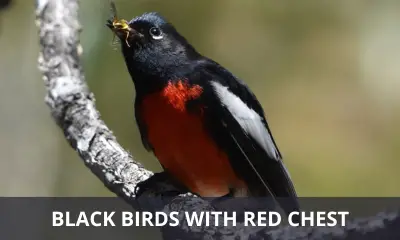
What are the types of black birds with red chests?
There are 21 types of black birds that have red chests, which are described in full detail below.
Note that only the first 5 of these (Painted Redstart, Rose-breasted Grosbeak, Vermilion Flycatcher, Red-breasted Sapsucker, and Pine Grosbeak) live in North America, while the rest hail from other parts of the world.
Painted Redstart
Scientific name: Myioborus pictus
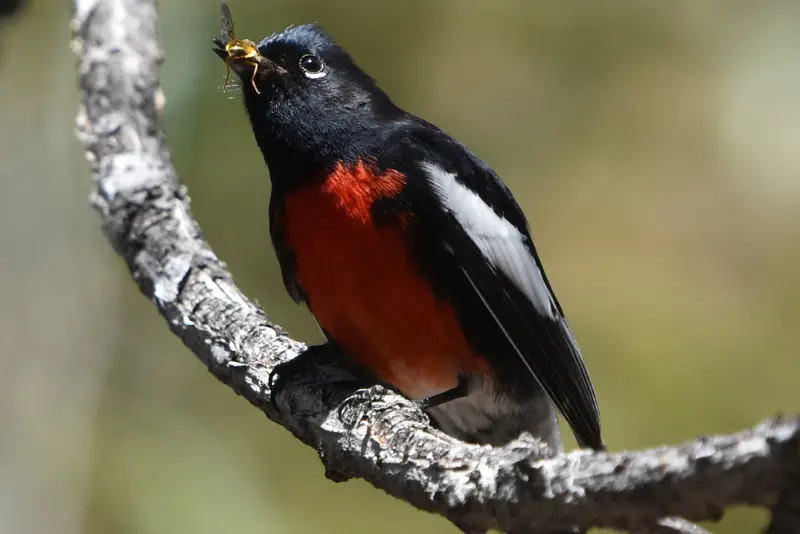
The Painted Redstart is a gorgeous wood warbler with a striking combination of red feathers contrasting with its black and white plumage.
Adult males are predominantly black, contrasting with a bright red chest, white patches on the wings, white tail feathers, and a small white patch under the eye.
Adult females and young birds resemble males, but their belly is gray instead of red.
These colorful black and red birds can be seen in the southwestern United States during the breeding season from March through September.
After the breeding season, the Painted Redstart migrates to Central America, where it spends the winter.
Rose-breasted Grosbeak
Scientific name: Pheucticus ludovicianus
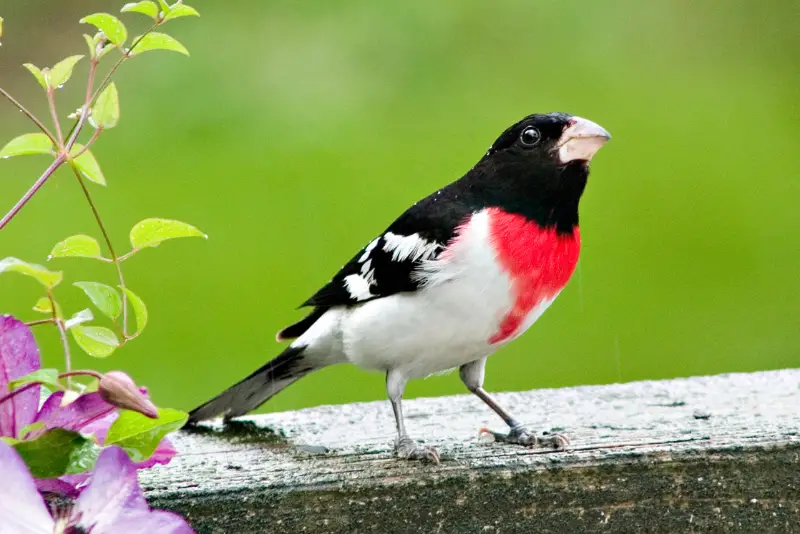
The Rose-breasted Grosbeak is easily identifiable due to its distinct markings and its large beak.
During the summer, adult males have a scarlet red chest, which contrasts with their jet black hood and back. Their black wings have white patches and white wing bars.
Adult females and immature birds, on the other hand, have streaked brown plumage that is lighter on the underside than on the back. They also have a white eyebrow stripe and white wingbar.
Rose-breasted Grosbeaks are summer visitors in North America from May through August.
This black and red bird is migratory, and flies to Central America to spend the winter months. Similar to other crossbill species, it specializes in feeding on the seeds of conifer cones.
Vermilion Flycatcher
Scientific name: Pyrocephalus obscurus
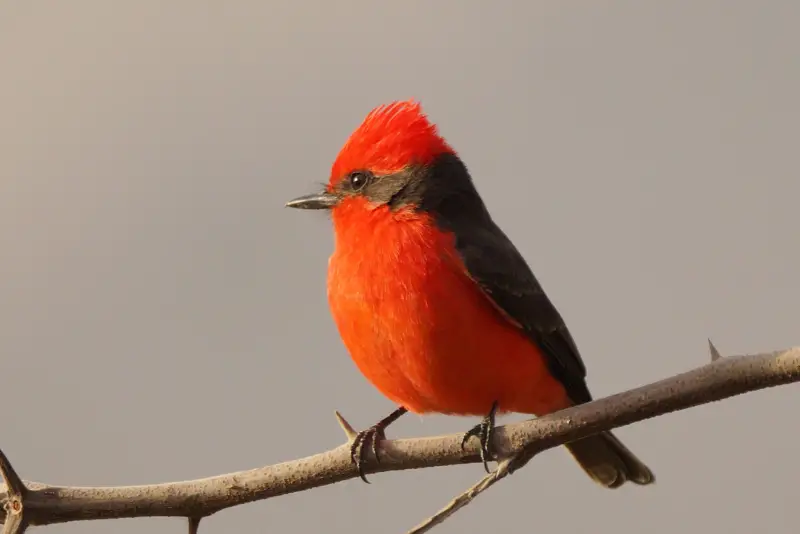
The Vermilion Flycatcher is one of the most beautiful red birds that can be seen in North America.
Adult males have a bright crimson underside, throat, and crown, while the rest of their body is dark brown.
Females and immatures, on the other hand, are grayish brown on top, and pale underparts.
It is a strict migratory bird, with most Vermilion Flycatchers migrating to Central America to spend the winter, with only a handful of individuals remaining in North America during the cold season.
A great thing about this gorgeous bird is that it isn’t very shy towards humans, and usually can be easily observed on exposed perches.
The preferred habitat of the Vermilion Flycatcher is open woodland and parks in areas close to water.
Red-breasted Sapsucker
Scientific name: Sphyrapicus ruber
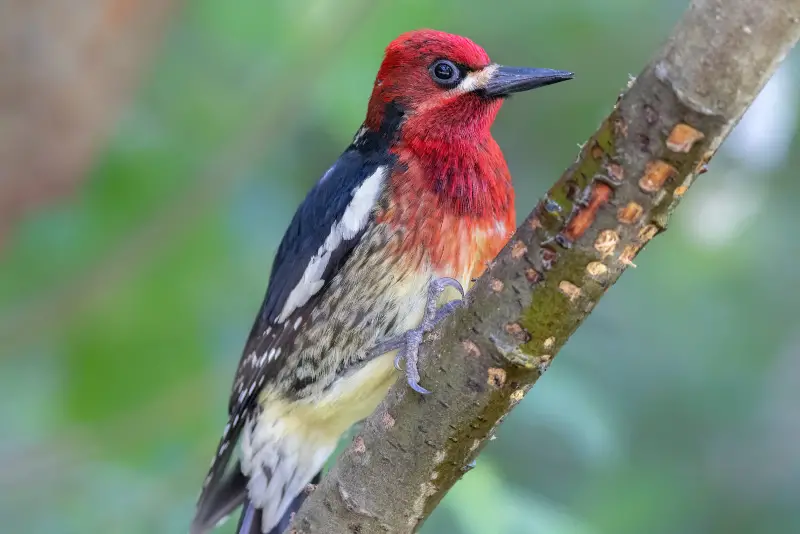
This bird is a strikingly colorful member of the woodpecker family, due to the combination of its scarlet red breast and red head with a black and white body.
The back is dark greenish black, while the belly is cream colored with dark spots and streaks. Juvenile birds look similar, but lack most of the red coloring.
These sapsuckers are birds of westernmost North America, and occur in a band along the coast from southern California all the way up to southern Alaska.
They are regular breeding birds in mixed forests, but are more common during winter, when there is an influx of northern sapsuckers that migrate to the southern United States to spend the winter.
Pine Grosbeak
Scientific name: Pinicola enucleator

The Pine Grosbeak is a small songbird with a red breast and black wings, as well as a short and stubby bill.
The adult males are raspberry red with varying amounts of gray on their sides and bellies. The tail and the wings are black with two white wing bars.
Females are more drab, and have a more brownish yellow coloration compared to the males.
This red and black bird breeds in the mountainous regions of North America, where it is a year-round resident.
During the cold season, there is an influx of northern Pine Grosbeaks that spend the winter in the United States.
Masked Crimson Tanager
Scientific name: Ramphocelus nigrogularis
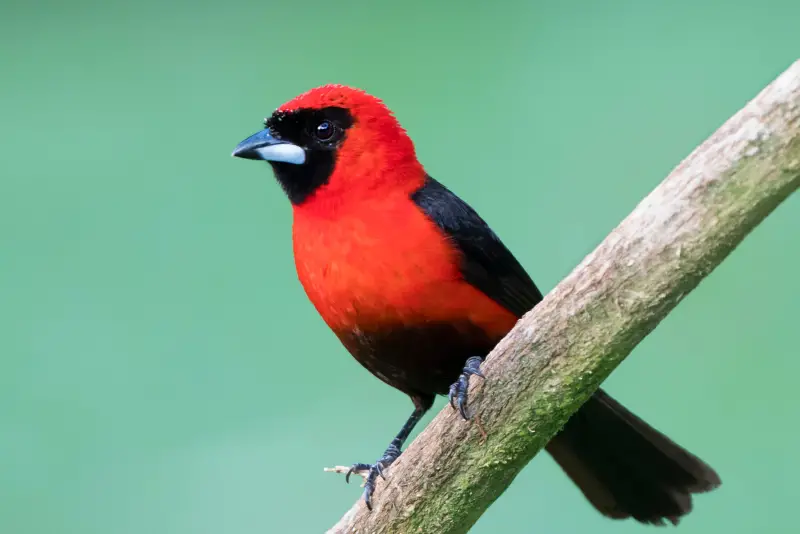
The Masked Crimson Tanager is a stunningly beautiful tropical bird found in the rainforests of northern South America.
And while this is not a North America bird, we decided to include it in this article since it does show up in the southern United States as a rare vagrant.
It’s easy to identify this colorful bird, due to its crimson and black feathers. Females look similar to males, but are slightly more drab.
Another great distinguishing feature is its silver colored lower bill, which contrasts with the black mask.
Crimson-collared Tanager
Scientific name: Ramphocelus sanguinolentus
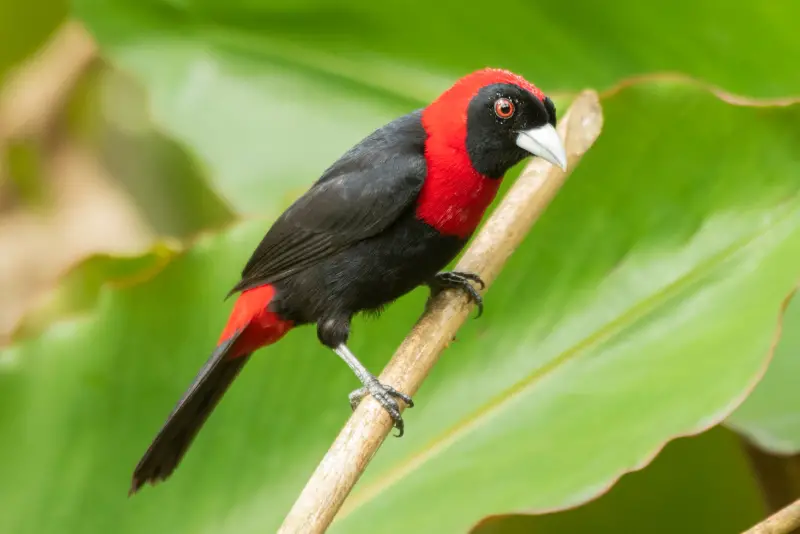
The Crimson-collared Tanager is a breeding bird of Mexico and Central America, but is spotted as a regular vagrant in southern Texas.
It is a bird of evergreen tropical rainforests, where it is most often observed foraging at the edges of clearings and along rivers.
The sexes resemble each other, and pairs are usually observed foraging together.
This red and black bird can be distinguished from the Masked Crimson Tanager by its entirely silver bill, while only the lower bill is silver in the latter species.
Red-breasted Chat
Scientific name: Granatellus venustus
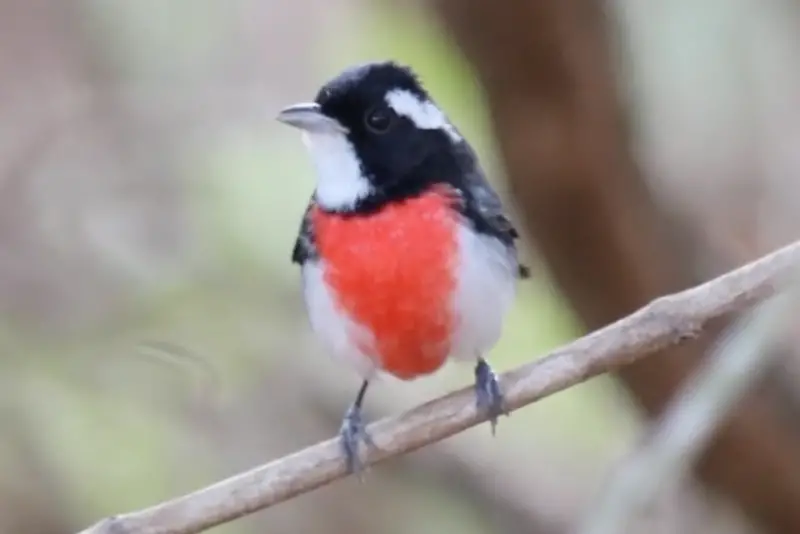
The Red-breasted Chat resembles a warbler, but is actually more closely related to grosbeaks and cardinals.
The male has a striking black head and shoulders, contrasting with its bright crimson breast. It also has a white throat and white eyebrow stripe, further adding to the color contrast.
Females and young birds are grayish brown. These birds are native to the lowlands of Central America, most notably Mexico and Guatemala.
Red-breasted Meadowlark
Scientific name: Leistes militaris
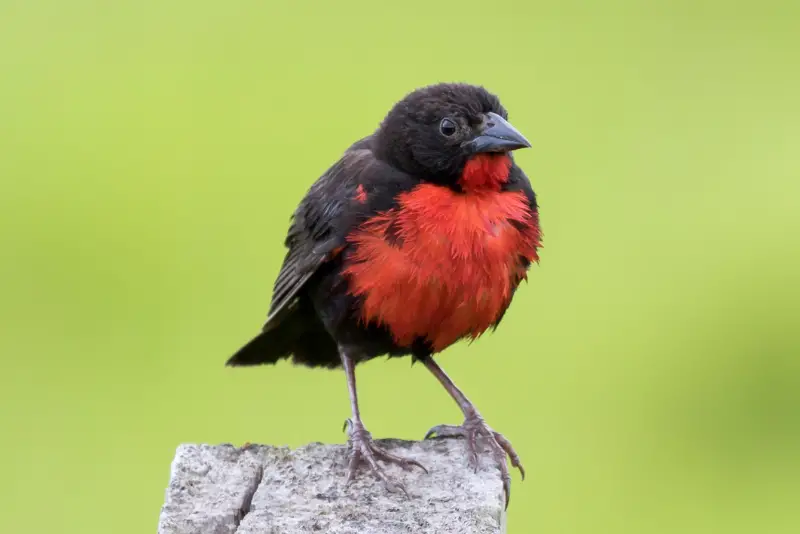
Also called the Red-breasted Blackbird (although it is not related to blackbirds), this beautiful meadowlark is found in grassland and other open areas of northern South America.
The male is an almost entirely black bird, except for its bright red chest and throat. Females are light brown with darker streaks.
This black bird forages on the ground similar to other meadowlarks, and feeds on both seeds and small insects.
Crimson-breasted Finch
Scientific name: Rhodospingus cruentus
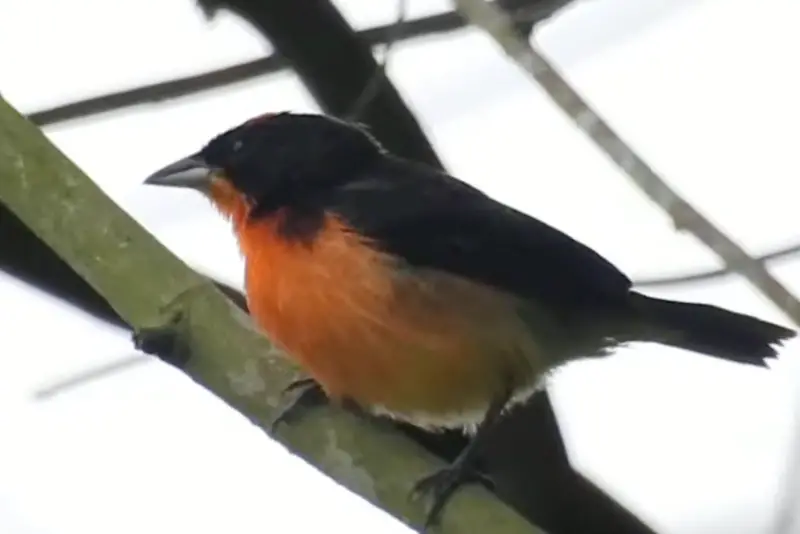
The Crimson-breasted Finch is a small songbird of the lowland forests of westernmost South America, most notably Peru, Ecuador, and Colombia.
The male is largely black with a fiery red breast and crown. The female is more subdued in color, and is uniformly brown.
These birds are found in forest undergrowth and the edge of forests, where they forage for seeds.
Scarlet-chested Sunbird
Scientific name: Chalcomitra senegalensis
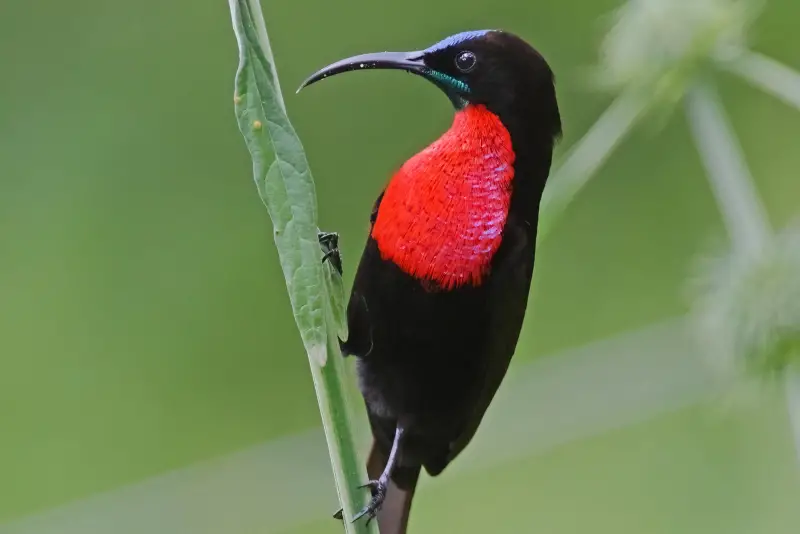
One of the most beautiful birds on this list, the Scarlet-chested Sunbird male is glossy black with a crimson red chest. In addition it also has an iridescent green forehead and throat.
Females are more inconspicuous, with a dark brown upper side and a cream colored underside streaked with small brown spots.
These sunbirds are found in savannah and other open habitats with scattered trees. They are native to large parts of Central Africa.
Crimson-breasted Shrike
Scientific name: Laniarius atrococcineus
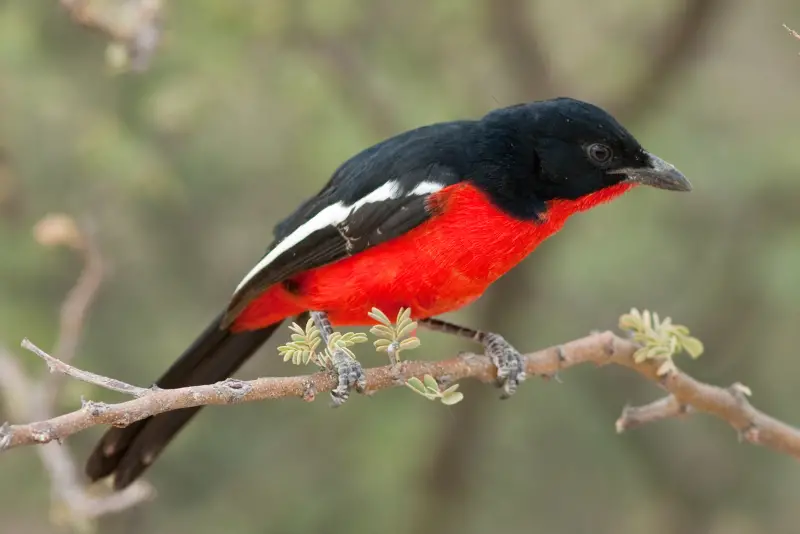
The Crimson-breasted Shrike belongs to the family of bush shrikes, and is native to South Africa.
The sexes look alike and both have jet black upper parts, including black wings and black tail, which contrast with their bright crimson underside.
They forage for insects in dry savannah and scrub land, and are regularly encountered as pairs or even small flocks.
Crimson-breasted Woodpecker
Scientific name: Dryobates cathpharius

The male Crimson-breasted Woodpecker is distinguished by its largely black upperside, as well as buff cream underparts as well as a red patch on its chest.
Females are more dull, and lack the bright red plumage. These small woodpeckers inhabit high altitude forests in east Asia, including Nepal, Burma, and China.
Scarlet Robin
Scientific name: Petroica boodang
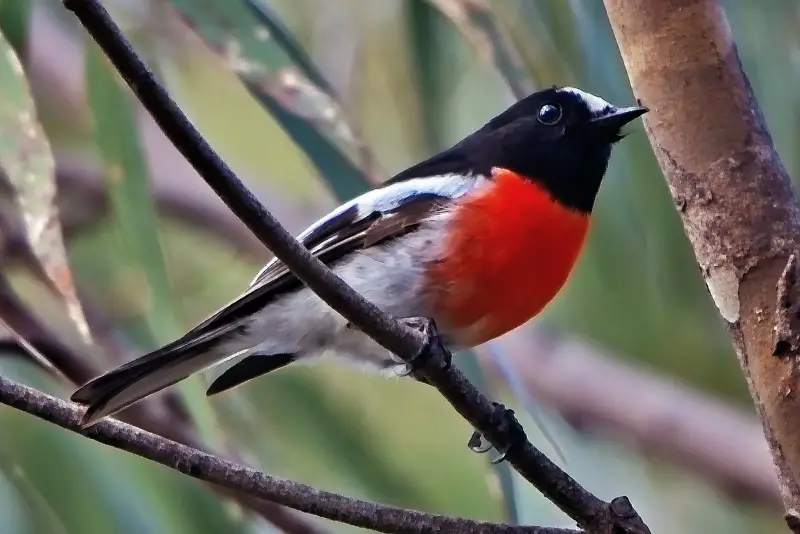
The Scarlet Robin is native to Australia, where it occurs in open forests as well as grasslands and cultivated farmland.
Males have a largely black upperside, contrasting with a bright orange chest. They also have a white forehead and white wingstripe.
Females, on the other hand, are largely gray brown, but also have a reddish orange patch on the chest.
Eurasian Bullfinch
Scientific name: Pyrrhula pyrrhula
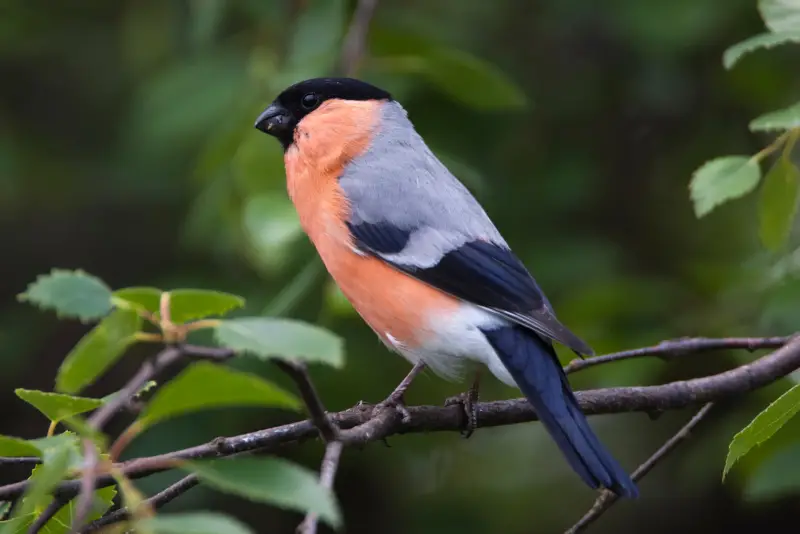
The Eurasian Bullfinch is a large finch found throughout Europe and western Asia, but it is uncommon in most parts of its range, and therefore rarely observed.
The male has a black head, black wings, and a black tail, as well as a gray back. The belly, breast, and cheeks are bright red.
Their preferred habitat are mixed forests, and edges of woodlands, as well as farmland and orchards.
Scarlet Honeyeater
Scientific name: Myzomela sanguinolenta
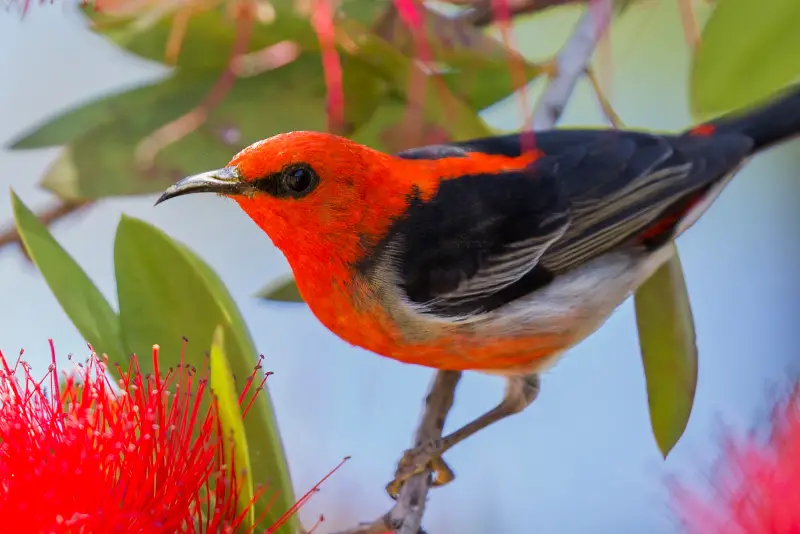
The Scarlet Honeyeater is a native of eastern Australia, where it is found in coastal forests, including mangrove forests.
Adult males have a brilliant red head and chest, as well as a black back, wings, and tail. Females are more dull, and are grayish brown.
This small honeyeater is easily overlooked, as it likes to forage high up in the canopy, where it is hard to spot.
Red-breasted Goose
Scientific name: Branta ruficollis
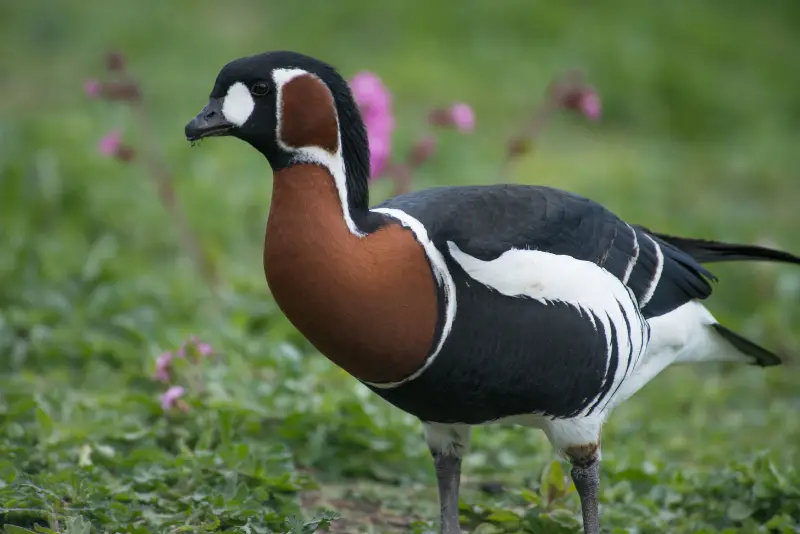
This small goose is native to northern Europe, and winters in central and eastern Europe, but is a rare bird throughout its range.
Adults have a black back and belly, as well as rusty red feathers on their throat and chest. They are often observed in mixed flocks together with other geese, such as Barnacle Geese.
These birds breed in coastal areas of the arctic tundra, and are mainly observed during migration.
Red-chested Swallow
Scientific name: Hirundo lucida
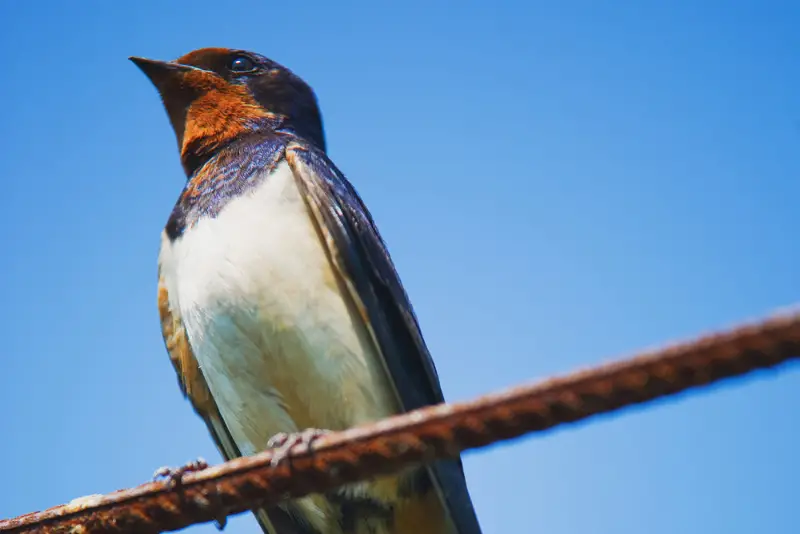
The Red-chested Swallow is a small swallow found in equatorial Africa. The dark upperside contrasts with a brick red breast, throat, and forehead.
It breeds in towns and human settlements, but forages over savanna and open grasslands. During winter, it can be easily confused with the Barn Swallow, which winters in the same areas.
Red-breasted Swallow
Scientific name: Cecropis semirufa
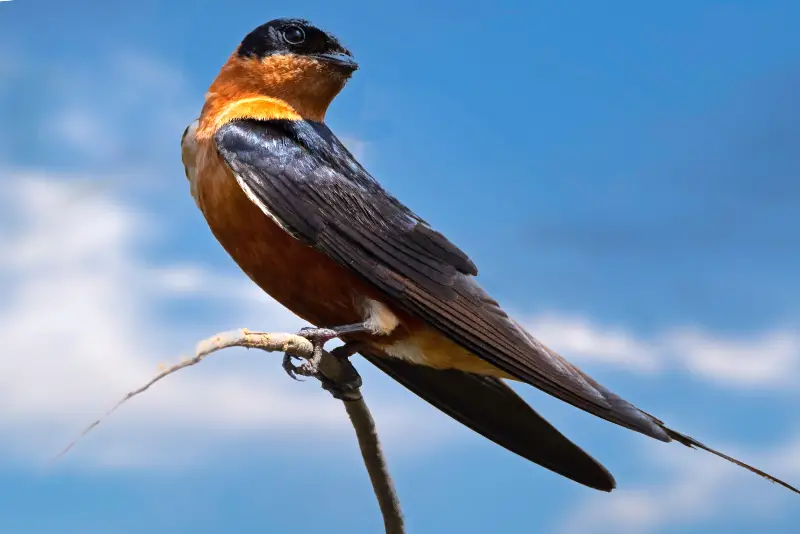
Also known as the Rufous-chested Swallow, this elegant long-tailed swallow is a native of sub-saharan Africa.
It has a brick red chest and underside, which contrasts with its dark blackish blue upperside.
In addition to its rufous rump, one of the best distinguishing features of this swallow are its very long tail streamers.
Great Frigatebird
Scientific name: Fregata minor
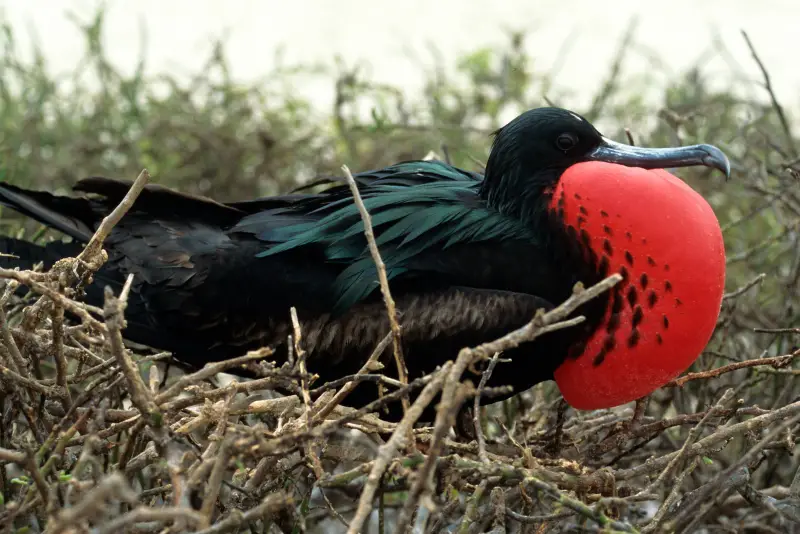
The Great Frigate Bird is a large seabird that nests on small islands in the equatorial zones of the Atlantic and Pacific oceans.
Males are uniformly black, except for their bright red throat pouch, which can cover their entire chest when inflated during courtship.
Females and immature birds are more inconspicuous with largely brown colors as well as a white chest and belly.
Magnificent Frigatebird
Scientific name: Fregata magnificens
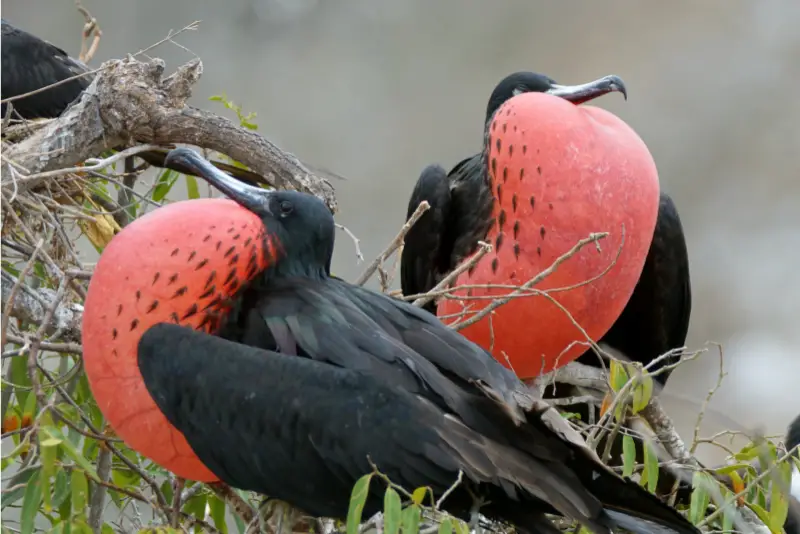
The Magnificent Frigatebird looks similar to the Great Frigatebird, but is not circumtropical in its range, and is instead most often encountered in the Caribbean and off the Pacific coast of Mexico.
Males are entirely black, except for their inflatable red pouch, while females are brown with a white belly.
Red Siskin
Scientific name: Spinus cucullatus
The Red Siskin is an endangered species that used to be common in the foothills of Venezuela, but that has unfortunately become very rare due to trapping for the bird trade.
Adult males have a characteristic red and black plumage, with a black head, wings, and tail contrasting with their orange red breast and underside.
The female is brownish gray. These birds are often encountered foraging together in small flocks.
Final remarks
In summary, here are the 21 types of black colored birds with red chest:
- Painted Redstart
- Rose-breasted Grosbeak
- Vermilion Flycatcher
- Red-breasted Sapsucker
- Pine Grosbeak
- Masked Crimson Tanager
- Crimson-collared Tanager
- Red-breasted Chat
- Red-breasted Meadowlark
- Crimson-breasted Finch
- Scarlet-chested Sunbird
- Crimson-breasted Shrike
- Crimson-breasted Woodpecker
- Scarlet Robin
- Eurasian Bullfinch
- Scarlet Honeyeater
- Red-breasted Goose
- Red-chested Swallow
- Red-breasted Swallow
- Great Frigatebird
- Magnificent Frigatebird
- Red Siskin
If you’ve spotted one of these birds, but aren’t sure which species it was, check our detailed ID guide with photos above.
If you enjoyed this article, check out our guide to the black birds with a white head.
